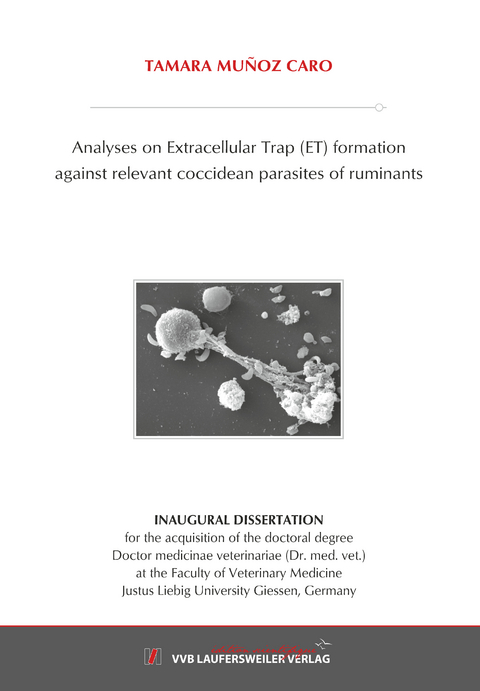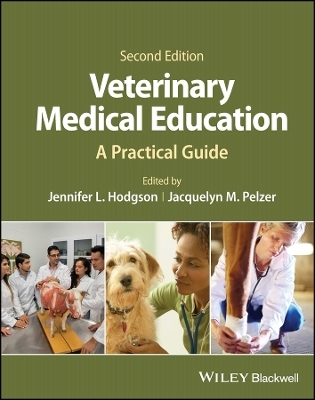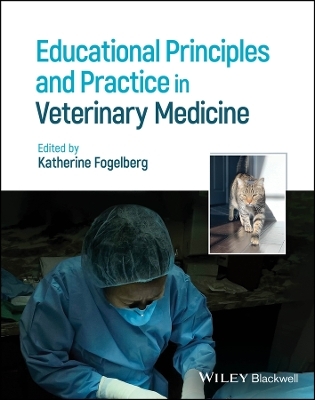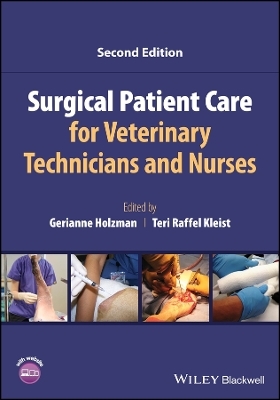
Analyses on Extracellular Trap (ET) formation against relevant coccidean parasites of ruminants
Seiten
2018
VVB Laufersweiler Verlag
978-3-8359-6702-1 (ISBN)
VVB Laufersweiler Verlag
978-3-8359-6702-1 (ISBN)
- Keine Verlagsinformationen verfügbar
- Artikel merken
Polymorphonuclear neutrophils (PMN) belong to the innate immune system and own different effector mechanisms for invasive pathogen attack. Amongst these, “Neutrophil Extracellular Trap” (NET) formation is utilized to combat pathogens in the extracellular compartment. In the present dissertation several different parasites, such as the protozoans Besnoitia besnoiti, Eimeria arloingi, Cryptosporidium parvum and Toxoplasma gondii as well as the nematode Haemonchus contortus were investigated for their ability to induce NET formation, and, except for T. gondii, these species were here identified for first time as NET inducers. Quantative analyses demonstrated that coccidia-triggered NETosis is a time- and dose-dependent effector mechanism. Furthermore, this effector mechanism revealed as a parasite- and host species-independent process, since sporozoites of other, mainly non-bovine apicomplexan species (e. g. Isospora suis, Eimeria arloingi) equally induced NETosis in bovine PMN. In line, PMN from different host origin, such as equine, canine and caprine PMN, equally released extracellular traps in response to the strict host-specific parasite E. bovis. In addition, not only sporozoites but also tachyzoites, merozoites and oocysts induced NET formation suggesting a stage-independent mechanism and thereby proposing NET formation as a generally valid effector mechanism against coccidian parasites.
To further characterize parasite-triggered NETosis, classical components of NETs, such as histones, neutrophil elastase (NE) and myeloperoxidase (MPO), were detected in NET structures via antibody-based co-localization experiments. In addition, the key role of these enzymes were proven by both, measurements of enzymatic activities and functional inhibition experiments. Regarding second messengers that might be involved in NETs, we analyzed the role of “store operated calcium entry” (SOCE). Given that chemical blockage of SOCE resulted in a significant reduction of Eimeria-triggered NET formation, parasite-triggered NETosis revealed as a calcium-dependent process. Since SOCE is also involved in the ERK1/2- and p38 MAP kinase-mediated signalling pathways, the role of these enzymes was investigated via western blot analyses revealing enhanced enzyme phosphorylation during E. bovis-induced NETosis. In agreement, chemical inhibition of ERK-MEK- and p38-mediated signal transduction led to reduced NET formation thereby indicating a key role of these signaling pathways for E. bovis-, C. parvum- and T. gondi-induced NETosis. Moreover, PMN-derived CD11b was here demonstrated for the first time to be involved in parasite-triggered NETosis. Thus, a significant upregulation of CD11b surface expression was detected upon PMN exposure to E. bovis sporozoites. In addition, antibody-mediated blockage of CD11b led to a significant decrease of sporozoite-triggered NET formation.
Scanning electron microscopic (SEM) analyses and parasite-entrapment assays highlighted the significant capability of NETs to entrap all parasite stages studied in the current dissertation. In accordance, host cell invasion assays confirmed that NET-triggered extracellular arrest of coccidian parasites effectively hampered these from active host cell invasion, as demonstrated for E. arloingi-, C. parvum- and B. besnoiti-stages. In addition, in vivo presence of NETs was here demonstrated via immunohistological analyses showing for the first time NET structures being in direct contact or close proximity to different Eimeria stages in intestinal tissue samples of E. bovis- and E. arloingi-infected animals.
Furthermore, other innate immune cells than PMN, such as monocytes and eosinophils, were here also proven to trigger ETs in response to parasitic stages. As an important finding, the formation of different morphological forms of NETs, such as “diffuse”, “spread” and “aggregated” NETs in response to nematode (H. contortus) larvae were here reported.
Overall and based on the current data, NETosis may significantly alter the outcome of coccidian infections via hampering parasitic stages from invading new host cells and thereby from proliferation in vivo.
To further characterize parasite-triggered NETosis, classical components of NETs, such as histones, neutrophil elastase (NE) and myeloperoxidase (MPO), were detected in NET structures via antibody-based co-localization experiments. In addition, the key role of these enzymes were proven by both, measurements of enzymatic activities and functional inhibition experiments. Regarding second messengers that might be involved in NETs, we analyzed the role of “store operated calcium entry” (SOCE). Given that chemical blockage of SOCE resulted in a significant reduction of Eimeria-triggered NET formation, parasite-triggered NETosis revealed as a calcium-dependent process. Since SOCE is also involved in the ERK1/2- and p38 MAP kinase-mediated signalling pathways, the role of these enzymes was investigated via western blot analyses revealing enhanced enzyme phosphorylation during E. bovis-induced NETosis. In agreement, chemical inhibition of ERK-MEK- and p38-mediated signal transduction led to reduced NET formation thereby indicating a key role of these signaling pathways for E. bovis-, C. parvum- and T. gondi-induced NETosis. Moreover, PMN-derived CD11b was here demonstrated for the first time to be involved in parasite-triggered NETosis. Thus, a significant upregulation of CD11b surface expression was detected upon PMN exposure to E. bovis sporozoites. In addition, antibody-mediated blockage of CD11b led to a significant decrease of sporozoite-triggered NET formation.
Scanning electron microscopic (SEM) analyses and parasite-entrapment assays highlighted the significant capability of NETs to entrap all parasite stages studied in the current dissertation. In accordance, host cell invasion assays confirmed that NET-triggered extracellular arrest of coccidian parasites effectively hampered these from active host cell invasion, as demonstrated for E. arloingi-, C. parvum- and B. besnoiti-stages. In addition, in vivo presence of NETs was here demonstrated via immunohistological analyses showing for the first time NET structures being in direct contact or close proximity to different Eimeria stages in intestinal tissue samples of E. bovis- and E. arloingi-infected animals.
Furthermore, other innate immune cells than PMN, such as monocytes and eosinophils, were here also proven to trigger ETs in response to parasitic stages. As an important finding, the formation of different morphological forms of NETs, such as “diffuse”, “spread” and “aggregated” NETs in response to nematode (H. contortus) larvae were here reported.
Overall and based on the current data, NETosis may significantly alter the outcome of coccidian infections via hampering parasitic stages from invading new host cells and thereby from proliferation in vivo.
| Erscheinungsdatum | 02.08.2018 |
|---|---|
| Reihe/Serie | Edition Scientifique |
| Sprache | englisch |
| Maße | 146 x 210 mm |
| Gewicht | 205 g |
| Themenwelt | Veterinärmedizin |
| Schlagworte | Doktorarbeit • Uni • Wissenschaft |
| ISBN-10 | 3-8359-6702-9 / 3835967029 |
| ISBN-13 | 978-3-8359-6702-1 / 9783835967021 |
| Zustand | Neuware |
| Informationen gemäß Produktsicherheitsverordnung (GPSR) | |
| Haben Sie eine Frage zum Produkt? |
Mehr entdecken
aus dem Bereich
aus dem Bereich
A Practical Guide
Buch | Hardcover (2024)
Wiley-Blackwell (Verlag)
145,95 €
Buch | Hardcover (2024)
Wiley-Blackwell (Verlag)
124,55 €
Buch | Softcover (2024)
Wiley-Blackwell (Verlag)
95,12 €


